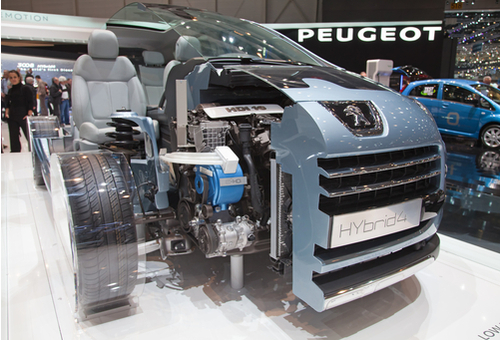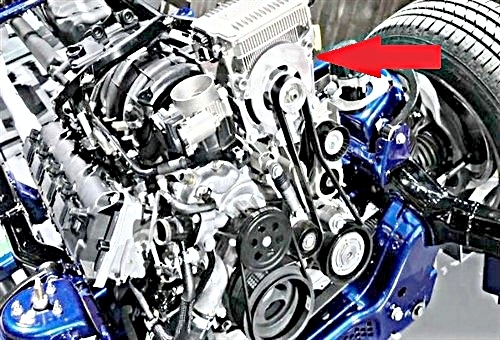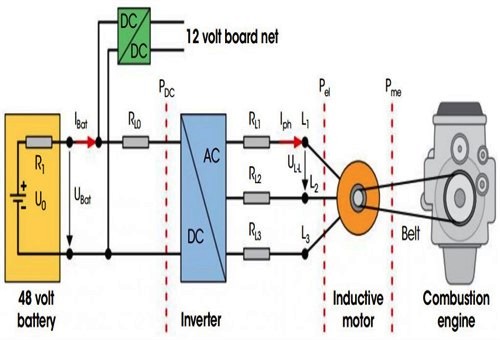
Chances are that you may have read or heard that many OEM manufacturers are investing enormous amounts of money in developing mild hybrid systems, such as the example shown above. In fact, many mainstream manufacturers from all markets have released one or more models running with 48-volt hybrid systems during the past few years, and many more will be released over the next few years, so you may be wondering what is driving this trend. In this article, we will take a closer look at 48-volt hybrid systems in terms of how they work, and what advantages, if any, these systems have over traditional, high-voltage hybrid systems, starting with this question-
Low voltage hybrid systems are not exactly a new invention; in the mid to late 1990s, several manufacturers had developed 42-volt hybrid systems, two of which were known as BAS (Belt Alternator Starter), and PHT (Parallel Hybrid Truck), respectively. While these systems worked, they suffered from several serious issues involving limited battery capacity, and unreliable electronic control/management systems, mainly because the materials, electronic components, and control systems/strategies that are available today did not exist in the late 1990s.
However, and even though the Insulated Gate Bipolar Transistors that form the heart of the control systems of modern high-voltage hybrid systems were just becoming available at the end of the 1990s, engineers were still faced with battery technologies that could not deliver the energy densities that were required to make proper use of advanced resistor technologies. As a result, all attempts to improve low-voltage hybrid systems were abandoned until comparatively recently, when advanced DC-DC converters and inverters that are based on Delphi Technologies’ “Viper inverter power switch” became widely available.
We need not delve into the technical details of inverter power switches here, beyond saying that this technology now allows for the construction of power converters and inverters that are at least 40% more compact and about 30% lighter than was possible to do before. Moreover, improved inverter switch technologies allows for a vast increase in the reliability of power electronics, and particularly the reliability of low-voltage power electronics. This is however only half of the story- the other half involves the development of low mass/high power-output battery technologies that in combination with improved electronics, can deliver power densities that are at least 25% higher than was possible to produce 20 years ago.
We are sure that while at least some readers may find the above interesting, it does not answer the question of why low-voltage hybrid systems run on 48 volts, and not on say, 60 volts, or even 100 volts. The answer is simple really; the regulatory authorities in the USA and Europe that compile and maintain safety standards for high-voltage circuits do not consider system voltages below 60-volts to be dangerous. Therefore, they have relaxed the rules that pertain to the personal safety of technicians that have to work on 48-volt systems, but there are also practical design considerations that make 48-volt hybrid systems viable alternatives to high-voltage systems, such considerations including-

The image above shows some details of the motor/generator assembly (arrowed) on a Dodge Ram e-Torque truck. Note that while there are significant design differences between low-voltage (aka mild hybrid) systems, all of the major components of the system are incorporated into one assembly in this design. Nonetheless, the biggest advantages that any mild hybrid system has over any high-voltage system are the facts that-
From a design perspective, these facts combine to reduce both vehicle weight and the costs of production and maintenance significantly, which is arguably the main reason why high-voltage hybrid vehicles have not penetrated their market segments as deeply as vehicle manufacturers had hoped-despite the high-voltage hybrids' proven fuel economy.
Nevertheless, despite their obvious advantages, mild hybrid systems have some drawbacks but before we get to that, we need to understand how mild hybrid systems are constructed, and how they work. Let us start with looking at the main components-
Battery pack
Just like in high-voltage hybrid battery packs, the cells in low-voltage battery packs are connected in series to produce battery modules, which are then also connected in series to produce a battery pack with a nominal capacity of 48 volts. In practice, such battery packs are small enough to fit almost anywhere in a compact vehicle although in most designs, the battery is located either in the boot or under a rear seat.
Motor / Generator
In designs where the motor/generator is separate from the power electronics, the unit usually fits where the alternator would have fitted on a conventional vehicle. With some exceptions, most notably on some Mercedes models in which the motor/generator is connected directly to the crankshaft, the motor/generators on mild hybrids are connected to the internal combustion engine via a drive belt between the crankshaft and the motor/generator, which begs this question-
While the idea of augmenting a conventional 12-volt system with a 48-volt system is common to all mild hybrid systems, the implementation of the basic premise varies greatly between manufacturers. For this reason, it is impossible to provide even basic information on each implementation, but we can do the next best thing, which is to provide a general, albeit much-simplified overview of how mild hybrid systems work in most designs, starting with-
Engine starting
The power limit of the 12-volt system on mot vehicles peaks at about 3 kW, which is insufficient to provide motive power in a hybrid setup, except in some Suzuki models. For the most part though, in mild hybrid systems, the 12-volt system is used exclusively for both interior and exterior lighting, as well as for most low-draw functions that would normally be powered by the 12-volt system on conventional vehicles.
So in practice, the AC that is generated by the motor/generator is converted by the inverter (which may or may not be incorporated into the battery control module), into DC to charge both the 12-volt and 48-volt batteries when the vehicle is in operation. Note though that the motor/generator’s output is modified by the DC-DC converter to suit both the charge rate and charging profile of the 12-volt battery.
Moreover, since most mild hybrid systems are of the stop-and-go variety, the motor/generator is used to start the engine* when the accelerator pedal is depressed, with switching between starter and generator modes occurring within the power control module. Note also that in most designs, the 12-volt and 48-volt systems share a chassis ground, which means that while the wiring and circuitry on mild hybrid systems are relatively uncomplicated, many ground issues can, and often do, affect both electrical systems.
*Note that in some designs, the conventional 12-volt starter motor is retained to provide a means of starting the engine when the 48-volt system fails, or if the drive belt between the motor/generator and the engine slips for whatever reason. Nonetheless, even when the 12-volt system is used to start the engine, the system will still operate on the stop-and-go principle.
Power delivery

Image source: Continental / https://x-engineer.org/automotive-engineering/vehicle/hybrid/mhev-electric-architecture/
The diagram above shows a generic layout of most mild hybrid systems that are in use today. Unlike high-voltage systems that require the placement of motor generators in large assemblies that resemble traditional transmissions, most mild hybrids supply motive power directly to the crankshaft of the internal combustion engine via a drive belt* that is equipped with special tensioning devices to limit belt slippage. In practice, the power that is generated by the motor/generator is added to the power generated by the engine, as opposed to the motor/generator replacing the power generated by the engine as happens in high-voltage hybrid systems.
*Note that on some applications, the drive belt is replaced by a chain that is internal to the engine to maximize power transfer.
Most mild hybrid systems can transfer about 30kW of power in this way, but it should be noted that since some losses occur in belt/pulley systems, some manufacturers are also maximising power transfer by mounting the motor/generator between the internal combustion engine and the drive wheels. The practical advantage of this arrangement is the fact that all of the power generated by the motor passes directly into the final drive since the parasitic drag caused by the engine is eliminated. As a practical matter though, these designs use a mechanical linkage much like a torque converter lockup clutch to allow for independent operation of the engine and the motor /generator under some conditions.
Nonetheless, just like high-voltage hybrid systems, mild hybrids also use an inverter to modify the battery packs’ DC into three-phase AC to power the motor /generator during times when additional torque is required. Most mild hybrid systems also use advanced algorithms to supply short bursts of additional power to the internal combustion engine to smooth out driveline vibrations during both start-up events and normal vehicle operation, which brings us to-
Although mild hybrids are exceptionally energy-efficient, these systems are not able to propel a vehicle on battery power alone beyond a few km, and then only at strictly limited speeds- such as maneuvering into a parking space or cruising through a parking lot looking for a parking spot close to the mall entrance.
As a practical matter, mild hybrids are neither designed nor intended to be used in the same way as conventional high-voltage hybrids, whose electric motors can propel a vehicle indefinitely. The primary driver behind the development of mild hybrids is to increase the efficiency of small-displacement internal combustion engines by using an electric motor to augment the output of the internal combustion engine under high-demand conditions, such for instance, overtaking slower vehicles.
While augmenting the power of an internal combustion engine by adding an electric motor and decoupling sources of parasitic power losses such water pumps, turbochargers, cooling fans, A/C compressors, etc, from the engine and operating them electrically results in measurable fuel savings and markedly reduced emissions, this comes at the cost of having to employ specialized-
Similar to high-voltage hybrid systems, current mild hybrid systems also use regenerative braking to generate a charging current that is used to charge both the 48-volt and 12-volt batteries. However, since the 12-volt and 48-volt systems share a common chassis ground, the 48-volt system is protected with a DC link that stabilises the DC voltage during times when the inverter causes large load variations the system.
This is required because when high-voltage batteries (48-volt batteries, in this case) are connected to loads with capacitive inputs, large “inrush” currents are created as the capacitance of loads are ramped up to match the battery voltage. Thus, since the 48-volt batteries in mild hybrid systems generally have low source resistances, inrush currents can easily build to and exceed 1000 Amps, hence the need to stabilise inrush currents with a DC link and a pre-charging circuit to protect control modules and other components such as relays during inverter switching events.
It is perhaps worth noting that since components such as electrically operated turbo/superchargers, water pumps, and power steering pumps are fed with 48-volts to increase their efficiency on some applications, current control strategies in use on today’s mild hybrid vehicles are centralised, which is another way of saying that a single DC-DC converter supplies all of these components with power from a central location.
While this system works reasonably well because it removes almost all parasitic power losses from the internal combustion engine, these systems generate extremely high temperatures and levels of electronic noise both in the AM band of radio frequencies and in the DC-DC converter when current is reduced to either the 3.5-volt or the 5-volt levels required by electronic control modules. Although current noise suppression and temperature control measures are effective, they are expensive and difficult to implement. Therefore, most OEM manufacturers are likely to introduce de-centralised power supply systems in the next generation of mild hybrid systems.
Essentially, in de-centralised systems, each electrical consumer will have a dedicated DC-DC converter, one or two consumers will share a DC-DC converter, or all (or most) electrical consumers will be adapted to accept direct 48-volt inputs. While all of the proposed system modifications will add somewhat to the complexity of the overall system, decentralising the power supply to consumers will make it easier to shield wiring and components more effectively against electronic noise, and to improve the regulation of voltages and currents to electrical consumers, which leaves us with this-
From our perspective as technicians, the single biggest advantage of mild hybrid systems is the fact that they will not cause fatal electrocution of the unwary among us. Nonetheless, and levity aside, the experience that we have gained in diagnosing, repairing, and servicing high-voltage hybrids means very little in the face of the rapid advances in low-voltage hybrid systems/technologies.
For instance, the significant differences that exist between current control strategies in low-voltage and high-voltage hybrid systems mean that for the most part, diagnostic principles and strategies that apply to high-voltage systems do not necessarily apply to low-voltage systems. This is particularly true of motor /generators; while most of us understand at least the basic operating principles of AC motor operation in high-voltage hybrid applications, some OEM manufacturers are now developing three-, and even four-phase brushless DC motors, about which none of us knows anything- at least, not yet.
The same is true for low-voltage power electronics. For instance, some manufacturers are working on ways to adapt the high-voltage systems we know to power 48-volt motor/generators through the use of fixed-ratio bus DC-DC converters to support a wider variety of power regeneration strategies. Other technologies under development include sine amplitude DC-DC converters that are capable of efficiencies of around 98% and power densities of at least 2.6kW / 16.3 cm3, levels that are unheard of in current high-voltage hybrid systems.
Thus, faced with an impending deluge of new, and advanced mild hybrid technologies that are coupled with a lack of service information from manufacturers, the only thing we can do is to approach mild hybrids in the same way that we approached the advent of high-voltage hybrids.
We studied the new technology, signed up for training courses, networked with colleagues in other parts of the world, and devised our own diagnostic strategies when service information was unavailable. Thus, we can either do the same things with mild hybrid systems, or begin to lose significant volumes of potentially profitable business to our competitors.